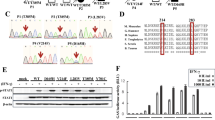Abstract
Primary immunodeficiency disorders (PIDs) are a heterogeneous group of inherited disorders that affect different components of the immune system. There are more than 150 different disorders which have been described till date. Despite major advances in the molecular characterization of PIDs over the last 20 years, many patients remain undiagnosed or are diagnosed too late with severe consequences. Recognizing different clinical manifestations of PID is the first most important step. It should be followed by use of appropriate diagnostic tools from a vast number of investigations available. This review will focus on important presenting features of PID and laboratory approach for diagnosis of suspected cases of PID.
Similar content being viewed by others
References
Al-Herz W, Bousfiha A, Casanova JL, Chapel H, Conley ME, Cunningham-Rundles C, et al. Primary immunodeficiency diseases: an update on the classification from the International Union of Immunological Societies Expert Committee for Primary Immunodeficiency. Frontiers in Immunology. 2011;2:54.
Piguet D, Tosi C, Luthi JM, Andresen I, Juge O. Redimune ((R)) NF Liquid, a ready-to-use, high-concentration intravenous immunoglobulin therapy preparation, is safe and typically well tolerated in the routine clinical management of a broad range of conditions. Clin Exp Immunol. 2008;152:45–49.
Notarangelo LD, Forino C, Mazzolari E. Stem cell transplantation in primary immunodeficiencies. Curr Opin Allergy Clin Immunol. 2006;6:443–448.
Subbarayan A, Colarusso G, Hughes SM, Gennery AR, Slatter M, Cant AJ, et al. Clinical features that identify children with primary immunodeficiency diseases. Pediatrics. 2011;127:810–816.
Slatter MA, Gennery AR. Clinical immunology review series: an approach to the patient with recurrent infections in childhood. Clin Exp Immunol. 2008;152:389–396.
Winkelstein JA, Marino MC, Ochs H, Fuleihan R, Scholl PR, Geha R, et al. The X-linked hyper-IgM syndrome: clinical and immunologic features of 79 patients. Medicine (Baltimore). 2003;82:373–384.
Berrington JE, Flood TJ, Abinun M, Galloway A, Cant AJ. Unsuspected Pneumocystis carinii pneumonia at presentation of severe primary immunodeficiency. Arch Dis Child. 2000;82:144–147.
Bouma G, Ancliff PJ, Thrasher AJ, Burns SO. Recent advances in the understanding of genetic defects of neutrophil number and function. Br J Haematol. 2010;151:312–326.
Wood P, Stanworth S, Burton J, Jones A, Peckham DG, Green T, et al. UK Primary Immunodeficiency Network. Recognition, clinical diagnosis and management of patients with primary antibody deficiencies: a systematic review. Clin Exp Immunol. 2007;149:410–423.
Zi Yin E, Frush DP, Donnelly LF, Buckleyl RH. Primary immunodeficiency disorders in pediatric patients: Clinical features and imaging findings. Am J Roentgeno. 2001;176:1541–1552.
Woellner C, Gertz EM, Schäffer AA, Lagos M, Perro M, Glocker EO, et al. Mutations in STAT3 and diagnostic guidelines for hyper-IgE syndrome. J Allergy Clin Immunol. 2010;125:424–432.
Zhang Q, Davis JC, Lamborn IT, Freeman AF, Jing H, Favreau AJ, et al. Combined immunodeficiency associated with DOCK8 mutations. N Engl J Med. 2009;361:2046–2055.
Buckley RH. The Hyper-IgE syndrome. Clin Rev Allergy Immunol. 2001;20:139–154.
Freeman AF, Collura-Burke CJ, Patronas NJ, Ilcus LS, Darnell D, Davis J, et al. Brain abnormalities in patients with hyperimmunoglobulin E syndrome. Pediatrics. 2007;119:e1121–1125.
Albert MH, Notarangelo LD, Ochs HD. Clinical spectrum, pathophysiology and treatment of the Wiskott-Aldrich syndrome. Curr Opin Hematol. 2010. Nov 11. [Epub ahead of print]
Madkaikar M, Currimbhoy Z, Gupta M, Desai M, Rao M. Clinical profile of leukocyte adhesion deficiency. Indian Pediatr. 2011;49:1–4.
Holland SM. Chronic granulomatous disease. Clin Rev Allergy Immunol. 2010;38:3–10.
Al-Muhsen S, Casanova JL. The genetic heterogeneity of mendelian susceptibility to mycobacterial diseases. J Allergy Clin Immunol. 2008;122:1043–1051.
Madkaikar M, Mhatre S, Gupta M, Ghosh K. Advances in autoimmune lymphoproliferative syndromes. Eur J Haematol. 2011;87:1–9.
Dessinioti C, Stratigos AJ, Rigopoulos D, Katsambas AD. A review of genetic disorders of hypopigmentation: lessons learned from the biology of melanocytes. Exp Dermatol. 2009;18:741–749.
Teachey D, Manno CS, Axsom KM, Andrews T, Choi JK, Greenbaum BH, et al. Unmasking Evans syndrome: T-cell phenotype and apoptotic response reveal autoimmune lymphoproliferative syndrome (ALPS). Blood. 2005;105:2443.
Melaranci C, Ciaffi P, Zerella A, Martinelli V, Cutrera R, Plebani A, et al. T cell subpopulation in paediatric healthy children: age-normal values. J Clin Lab Immunol. 1992;38:143–149.
Walshe D, Gaspar HB, Thrasher AJ, Cale CM, Gilmour KC. Signal transducer and activator of transcription 5 tyrosine phosphorylation for the diagnosis and monitoring of patients with severe combined immunodeficiency. J Allergy Clin Immunol. 2009;123:505–508.
Henter J, Horne A, Aricó M, Egeler RM, Filipovich AH, Imashuku S, et al. HLH-2004: Diagnostic and therapeutic guidelines for hemophagocytic lymphohistiocytosis. Pediatr Blood Cancer. 2006;48:124–131.
Janka GE. Familial and acquired hemophagocytic lymphohistiocytosis. Eur J Pediatr. 2007;166:95–100.
Caminha I, Fleisher TA, Hornung RL, Dale JK, Niemela JE, Price S, et al. Utilizing biomarkers to predict the presence of FAS mutations in patients with features of the autoimmune lymphoproliferative syndrome. J Allergy Clin Immunol. 2010;125:946–949.
Author information
Authors and Affiliations
Corresponding author
Rights and permissions
About this article
Cite this article
Madkaikar, M., Mishra, A. & Ghosh, K. Diagnostic approach to primary immunodeficiency disorders. Indian Pediatr 50, 579–586 (2013). https://doi.org/10.1007/s13312-013-0171-4
Published:
Issue Date:
DOI: https://doi.org/10.1007/s13312-013-0171-4




